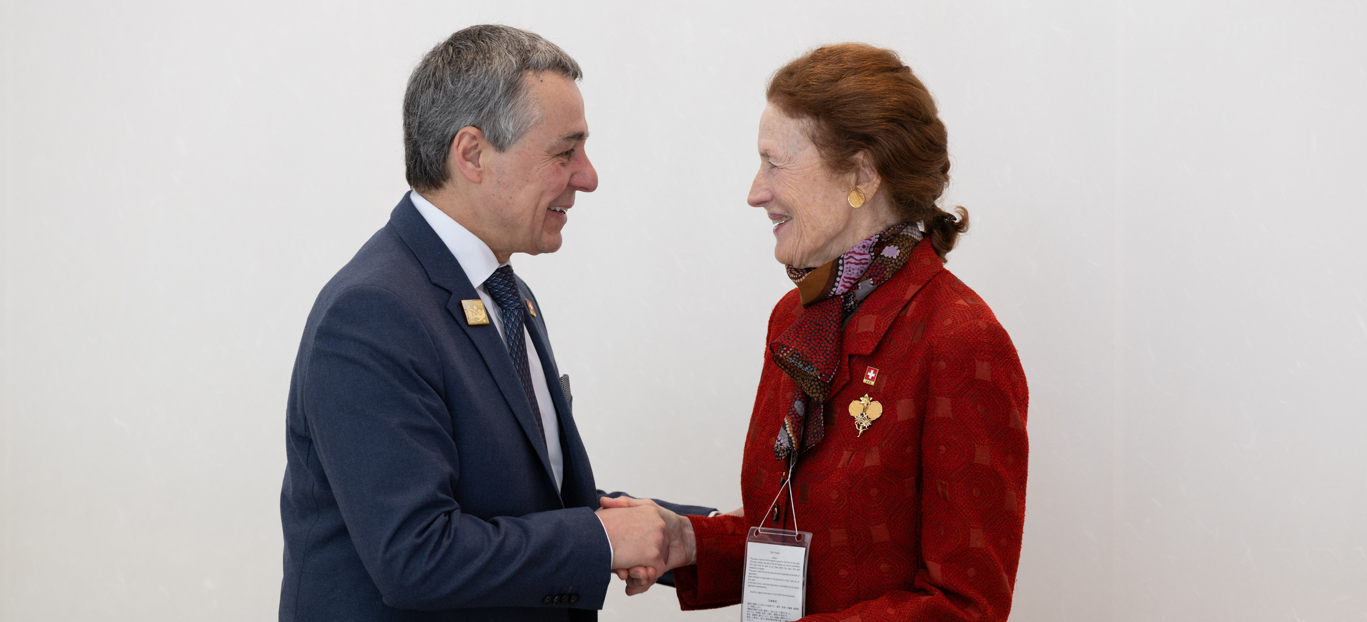Modern research tools, especially computational resources, are enabling deeper analysis of group behavior. (Mauro Mora/Unsplash)
Tapping into the behavioral science of groups holds promise for enhancing cooperation and limiting conflict
Over the next 25 years, we can anticipate several advancements in the study of group behavior that will benefit society, ranging from predictive tools for conflict prevention to more robust methods for leveraging the collective intelligence of groups, the 2024 GESDA Science Breakthrough Radar® says.
Researchers are increasingly using sophisticated data-driven models and modern technology to analyze group behavior and gain strategic foresight about how individuals come together and act collectively. This research focuses on how group dynamics, such as cooperation and conflict, can be predicted based on psychological and social factors influenced by both individual behavior and broader societal trends.
This understanding is significant for several reasons. First, it helps us grasp the psychological mechanisms behind group formation and dissolution, addressing crucial questions about why tensions can escalate into violence or why peaceful communities suddenly become hostile. By understanding the intricacies of group behavior, we can develop interventions aimed at fostering cooperation and preventing conflict, particularly in an era where digital communication and social media are redefining how groups interact.
In an invited contribution to the Radar, Mina Cikara, a psychology professor and director of the Intergroup Neuroscience Lab at Harvard University, discusses how distorted perceptions and assumptions about others, particularly in political and social contexts, can exacerbate conflicts. Cikara, who also chaired the Radar’s section on the behavior science of groups, says people tend to harbor negative meta-perceptions, which are beliefs about what they think others believe about them. These misperceptions fuel distrust and hostility, creating a barrier to constructive dialogue and collaboration.
Notably, research demonstrates that when individuals are informed that their opponents are less hostile than they assumed, it can lead to a reduction in antagonistic attitudes. This educational approach has shown effectiveness across different cultures and political climates, indicating the potential for mitigating conflict through improved communication and understanding.
Additionally, her contribution highlights the role of digital communication and socio-political narratives in shaping these perceptions. Algorithms and media can amplify negative views, leading to increased polarization and making it challenging for individuals to see common ground.
“As a social psychologist, I have come to understand that our worst acts are often carried out in service of good group membership. Our ideas of what is acceptable, fair or just change dramatically when our psychological viewpoint shifts from ‘me and you to ‘us and them.’ Intergroup dynamics are thus a critical boundary condition on our most cherished theories of morality, justice and human nature,” she writes.
“And yet we still don’t have a deep understanding of what a group actually is, or how it behaves. And how do we know to which groups we belong? How do we assign others to groups? Why do those assignments sometime change so abruptly and brutally? How do people go, in only a few years, from marrying one another and raising each other’s children to supporting or even participating, in genocide?”
Leveraging insights to accelerate progress towards the Sustainable Development Goals (SDGs)
Behavioral science groups within the United Nations and other organizations have been turning to the behavioral science of groups to design interventions and policies that promote the 17 global goals adopted in 2015 to end poverty, protect the planet, and spread peace and prosperity by 2030. Most of the goals, however, remain off-track with just five years left to achieve them, according to the UN’s 2024 progress report on the SDGs.
The field is key to understanding the many challenges to achieving the SDGs, like transitioning to clean energy or addressing inequalities, which require changes in human behavior. It can provide tools to understand why people make certain choices, and nudge them towards more sustainable or beneficial behaviors. It also helps identify and address the behavioral barriers that prevent people from adopting sustainable practices or following policies.
The behavioral science of groups informs the design of interventions, policies, and communications that are more likely to be effective in promoting desired changes, such as making it easier for people to understand the impact of their actions on climate change and offering practical alternatives.
Other useful areas include shaping sustainable consumption patterns, like reducing food waste or using energy more efficiently, and motivating efforts to end illegal wildlife trade or reduce overfishing. In public health, the uses range from helping people adopt new behaviors, such as taking medication or seeking medical care, to designing a training toolkit on the social norms needed to improve road safety.
Over the next quarter century we can anticipate several advancements in this field that will benefit society, according to the Radar. For example, enhanced algorithms and models are expected to allow for real-time monitoring of social dynamics, enabling governments and organizations to intervene before conflicts escalate. Lessons learned from data likely will lead to tailored interventions that are context-specific rather than one-size-fits-all, improving the effectiveness of conflict resolution efforts.
Collaboration between artificial intelligence technologists and social scientists can improve decision-making processes, allowing for a deeper understanding of group dynamics in varying contexts, from workplaces to communities. Future research is likely to uncover more robust methods for leveraging the collective intelligence of groups, improving outcomes in teamwork and community projects.
The focus on collective cognition – how groups of people “think” as a unit – can lead to better strategies for group decision-making that diversify perspectives while minimizing groupthink. The aim is to create more harmonious societies and improve our ability to address complex challenges collaboratively.
“Looking forward, I think that individuals, institutions, and governments have a deep responsibility (and challenge) to communicate accurately just how close we are in our values and desires. People now have access to unprecedented volumes of information, but they need to see how much distributions of attitudes and issue positions overlap,” Cikara concludes. “The provision of reliable information from trustworthy sources to a data literate public is paramount for large scale collective coordination.”
Where the science and diplomacy can take us
The 2024 GESDA Science Breakthrough Radar®, distilling the insights of 2,100 scientists from 87 countries, says that with the tools of modern research, it is becoming possible to identify, monitor and predict how individuals cohere into groups, and how those groups behave and interact with each other — to assess collective emotion as well as collective action.
The findings in the 2024 Science Breakthrough Radar®
Based on the Radar, here’s where we stand in several important areas:
→ 🔗 4.5 Behavioral science of groups
Today’s efforts are more often geared towards resolution — trying to stop conflict once it has already begun — rather than prevention. New methods of monitoring both top-down forces (such as messaging from elites, or economic trends) and bottom-up trends (prevailing social attitudes) are changing this, potentially allowing conflict to be anticipated.
→ 🔗 4.5.1 Understanding intergroup dynamics
Historically, researchers were limited to comparatively simple models, for example, those based on correlations between the prices of basic foodstuffs and likelihood of civic disorder. The increased availability of continuous data about movements, communication and interactions makes it possible to develop refined models and test them against real data based on top-down forces and bottom-up trends.
5-year horizon: Useful datasets expand
10-year horizon: Behavioral science research environment matures
25-year horizon: Conflict prediction models adopted by global organizations
→ 🔗 4.5.2 Predicting the onset of armed conflict
The 21st century has provided ample evidence of the far-ranging effects of armed conflict. Beyond the toll of immediate death and destruction, the interconnectedness of today’s world means there can be significant political, economic and social repercussions far from the fighting. Predicting conflicts with the aim of preventing them is a stated objective of organizations such as the United Nations and World Bank.
5-year horizon: Machine-learning models improve conflict risk-detection
10-year horizon: Explicable ML facilitates better understanding of conflict prediction
25-year horizon: Conflict prediction models adopted by global organizations
→ 🔗 4.5.3 Optimization of intervention research
Many instances of conflict stem from deteriorating intergroup relations: one community or bloc begins to mistrust another, reducing cooperation and leading to outright antagonism. In response, social scientists formulated interventions to improve relations by reducing bias, hostility or negative behaviors. This approach has had some success measured by improvements in key variables such as trust and inclusivity.
5-year horizon: Intervention science matures
10-year horizon: Careful deployment of interventions begins
25-year horizon: Refined, customizable interventions improve intergroup relations
→ 🔗 4.5.4 Interaction with wider global trends
Several megatrends are changing how intergroup conflict plays out. The changing climate, for instance, alters the viability of some lifestyles while opening up new ones — pastoralism versus mining in the Arctic, for example. The face-off between major powers has given way to a new, more multipolar environment in which nations simultaneously collaborate and compete or enter into new alliances and alignments. These factors significantly change global mobility and lead to novel intergroup interactions.
5-year horizon: Research develops solutions to disinformation
10-year horizon: Migration creates novel interactions
25-year horizon: Research facilitates addressing global challenges as they arise
→ 🔗 Invited Contribution: Misperceptions, meta-perceptions and conflict
The evidence is overwhelming that humans are by default cooperative, moral and deeply averse to harming others. Our very co-existence in cities with millions of residents, on a planet with billions of inhabitants, testifies to that. And yet, by some counts, over 200 million civilians have been killed in acts of genocide, war, and other forms of collective conflict over the last century alone.










